MARKET OVERVIEW
The global oxygen therapy devices market is a part of the larger medical devices segment that specializes in products that provide supplemental oxygen to patients suffering from respiratory diseases. The products are intended to supplement people whose lungs cannot take in sufficient oxygen from the atmosphere, allowing them to have enough oxygen for survival and enhanced quality of life. Over the next few years, the global oxygen therapy devices market will advance further as healthcare systems continue to demand effective and responsive solutions for coping with chronic and acute breathing difficulties.
It encompasses a variety of products that supply oxygen through various mechanisms, generally customized for different clinical and non-clinical environments. The products are no longer limited to hospitals; their applications will become increasingly directed towards outpatient treatment, home care, and emergency health services. With developments unfolding in all areas of therapeutic approaches, the products employed in oxygen supply will be required to conform to more adaptable and transportable configurations. These transitions will alter the nature of patient experience for extended respiratory therapy, compelling manufacturers to design solutions that combine precision, security, and convenience of use.
In the coming decade, the global oxygen therapy devices market will not stay fixed. It will follow wider transformations in healthcare, particularly as patient-focused models become dominant. The manufacturers of devices will address clinical requirements as much as they will accommodate demands for low-key, portable, and self-manageable technologies. Though traditional oxygen cylinders and concentrators will continue to be useful, their digital counterparts with monitoring features and smart controls will increasingly command market share. These shifts will require ongoing design and function refinement, particularly to guarantee that oxygen flow is consistent irrespective of the circumstance in which a patient finds themselves.
Technology development, however, will not solely determine this market's future. Regulatory requirements, local policies, and patient care accessibility will determine how and where these products are adopted. Varying areas will undertake distinct approaches depending on healthcare infrastructure and patient requirements. For instance, while some countries will be geared towards decentralized care via home-based oxygen systems, others will concentrate on centralized distribution in medical facilities. The manufacturers will have to cater to such diversity, adapting their solutions for various application scenarios without sacrificing performance or safety.
Another interesting feature of the global oxygen therapy devices market will be its relationship with global health readiness. Recent public health crises have highlighted the importance of quick deployment of life-supporting medical devices, and oxygen delivery devices will continue to be at the forefront of these efforts. Strategic stocks, modulable production methods, and logistics planning will become increasingly important factors. Consequently, device suppliers will go beyond providing to hospitals or clinics and become part of more comprehensive health resilience planning.
In the future, the global oxygen therapy devices market's identity will further evolve beyond what it does today. It will not only react to specific respiratory cases but will also become an integral part of the structure of how healthcare systems prepare for readiness and provide long-term care. Entities in this industry will need to navigate through technical, logistical, and ethical aspects as they find congruence with the changing needs of healthcare practitioners and patients.
Global oxygen therapy devices market is estimated to reach $4,355.69 Million by 2032; growing at a CAGR of 4.3% from 2025 to 2032.
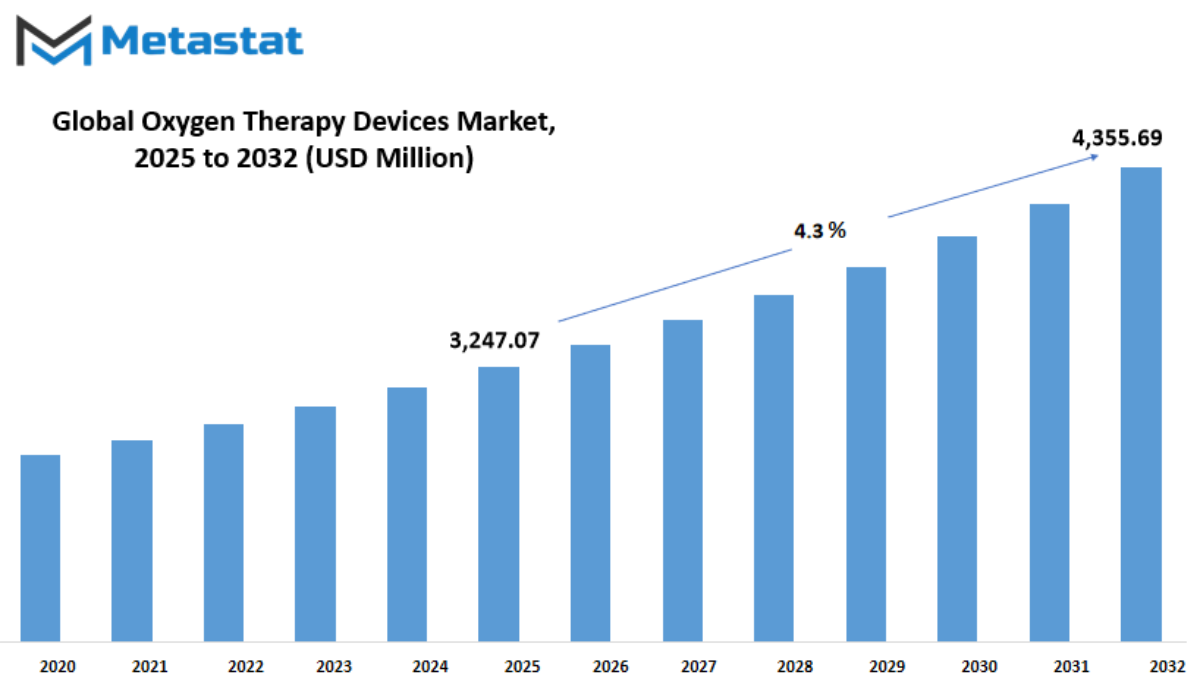
GROWTH FACTORS
The global oxygen therapy devices market is expected to experience steady progress in the coming years, driven by both medical needs and technological advancements. One of the main reasons for this growth is the rising number of people suffering from chronic respiratory illnesses such as chronic obstructive pulmonary disease (COPD) and asthma. These conditions often require long-term oxygen therapy, making dependable oxygen devices essential for maintaining quality of life. Alongside this, the growing elderly population plays a major role in boosting demand. Older individuals are more likely to face breathing problems and other related complications, which increases the use of oxygen therapy in day-to-day care.
The market will also see a shift due to changes in how healthcare is delivered. More people are turning to home-based care options, and oxygen therapy is no exception. Devices that can be used at home, especially portable ones, are gaining popularity. This is because they offer freedom and comfort, allowing users to manage their conditions without frequent hospital visits. The growing use of such devices not only improves the lives of patients but also reduces pressure on healthcare systems.
However, not all aspects of the global oxygen therapy devices market show smooth progress. One challenge is the high cost of advanced equipment. Many of the newer models are expensive, which makes them harder to afford for people in low-income areas. On top of that, some regions still face limited access to proper healthcare infrastructure. This can affect both the availability of oxygen therapy and the ability to maintain or repair the devices when needed. As a result, even though the demand is there, meeting it in these regions will remain difficult unless there are improvements in healthcare delivery and affordability.
Despite these hurdles, the future still holds promise. Ongoing research and development efforts are likely to lead to more user-friendly and cost-effective solutions. The market is also expected to benefit from public and private sector investments focused on improving respiratory care. As technology advances, we may see devices becoming smarter, lighter, and more efficient. Features like remote monitoring and automatic adjustment based on patient needs will further increase their value.
Looking ahead, the global oxygen therapy devices market will continue to expand, shaped by a mix of patient needs, healthcare trends, and innovation. The focus will shift more towards comfort, convenience, and wider accessibility, making oxygen therapy an easier part of daily life for many around the world.
MARKET SEGMENTATION
By Oxygen Source Equipment
The global oxygen therapy devices market is expected to grow steadily as healthcare demands increase and technology continues to shape the way care is delivered. Oxygen therapy has become a common part of treating people with conditions that make it hard to breathe. These include chronic diseases such as COPD and asthma, but also short-term issues like severe infections or post-surgery recovery. As populations age and respiratory diseases become more widespread, the need for oxygen therapy devices will likely rise, pushing the market forward in the years to come.
Looking ahead, one important part of the global oxygen therapy devices market is the category based on oxygen source equipment. This is broken down into oxygen concentrators, liquid oxygen devices, and oxygen cylinders. Oxygen concentrators are devices that pull oxygen from the air and deliver it to the patient in a purified form. They are growing in popularity because they are cost-effective, easy to use at home, and don’t require regular refilling. In the future, these machines will likely become smaller, quieter, and even more user-friendly, which will allow more patients to manage their condition without needing to visit a hospital.
Liquid oxygen devices are often used for patients who need a high flow of oxygen. These systems can store a large amount of oxygen in a compact form and release it as needed. As new materials and insulation techniques are developed, these devices might become lighter and more portable, making them more accessible for personal use. This could open the door to more patients using liquid oxygen at home or while on the move, improving their quality of life and reducing the need for long hospital stays.
Oxygen cylinders are another well-known option, and they continue to be used widely, especially in places where newer systems are not available. While they require regular replacement and are heavier, advancements in cylinder materials and pressure control may lead to better, safer, and easier-to-handle products in the future. More efficient refilling options may also support their continued use in both emergency and long-term care.
Overall, the global oxygen therapy devices market is set for long-term growth. As patient needs change and technology evolves, oxygen source equipment will keep improving. This will likely lead to better outcomes, more comfort, and increased independence for people who rely on oxygen therapy every day.
By Oxygen Delivery Devices
The global oxygen therapy devices market will continue to expand as the need for respiratory care grows. With the rise in chronic illnesses like asthma, COPD, and other breathing disorders, oxygen therapy is becoming more important in both emergency and long-term care. People are living longer, and with that comes an increased risk of developing conditions that affect breathing. This makes oxygen therapy devices an essential part of modern healthcare systems. Hospitals, clinics, and even home settings are relying more on these devices to support patients who need help with oxygen intake.
One major segment of this market focuses on oxygen delivery devices. These include Oxygen Masks, Nasal Cannulas, Venturi Masks, Non-rebreather Masks, Bag-valve Masks, and Cylinders, along with other tools. Each of these plays a specific role in helping patients get the right amount of oxygen. For example, nasal cannulas are often used for patients who need low to moderate oxygen support, while non-rebreather masks are used for more critical situations. Bag-valve masks are commonly used during emergencies when manual ventilation is required. Cylinders are also vital, especially in places where centralized systems aren't available or practical.
Looking ahead, the global oxygen therapy devices market will likely grow due to advancements in healthcare technology. More lightweight and portable options will become available, making it easier for people to use these devices at home or while traveling. Improved battery life, user-friendly controls, and remote monitoring features will become standard. This will help patients maintain better control over their treatment while reducing the need for constant hospital visits.
Governments and health organizations are also paying more attention to respiratory care, especially after recent global health events. This will lead to better funding, more research, and faster development of new devices. As these devices become more affordable and easier to use, more people will have access to them. Manufacturers will continue to improve their products, focusing on comfort, effectiveness, and ease of use.
As the world becomes more aware of respiratory health, the global oxygen therapy devices market will keep growing. More people will seek these tools to manage chronic issues or recover from illness. The future of this market lies in smart, efficient devices that fit smoothly into everyday life, offering people a safer and more comfortable way to breathe better.
By Portability
The global oxygen therapy devices market is expected to grow steadily over the coming years, driven by advancements in healthcare technology and the growing need for respiratory support. As the global population ages and more people experience breathing problems related to chronic diseases like COPD and asthma, the demand for oxygen therapy devices is set to increase. With a focus on improving patient comfort and offering better mobility options, manufacturers are working on innovative solutions that will meet future healthcare needs more efficiently.
When looking at this market by portability, it can be divided into stationary devices and portable devices. Stationary oxygen therapy devices are typically used at home or in clinical settings. They offer reliable support for patients who need oxygen for extended periods each day. These machines are designed to deliver a constant flow of oxygen, which is especially useful for individuals who are not able to leave their homes often. As the need for long-term respiratory care rises, stationary devices will continue to be an important part of the market.
On the other hand, portable oxygen therapy devices offer flexibility and independence. These are compact, lightweight units that allow patients to move around freely while still receiving the oxygen they need. With more people wishing to maintain active lifestyles despite having respiratory conditions, portable devices are becoming increasingly popular. In the near future, it is likely that these devices will become even smaller, easier to carry, and more efficient. This will help people with breathing difficulties live more normal lives and participate in daily activities without feeling limited by their condition.
Looking ahead, the global oxygen therapy devices market will likely benefit from advances in artificial intelligence and smart health monitoring. Devices that can track oxygen levels in real-time and adjust flow rates automatically will improve both safety and ease of use. Healthcare providers will also gain from data-driven insights, helping them offer better and more timely care. As awareness around respiratory health continues to grow, and with new technologies improving treatment methods, this market will keep expanding.
In summary, both stationary and portable oxygen therapy devices play key roles in meeting patient needs. The future holds strong potential for this market, with continued innovation leading the way. The global oxygen therapy devices market will be shaped by the changing needs of patients and the technology that supports them.
By Application
The global oxygen therapy devices market will continue to grow steadily due to the increasing number of people facing breathing-related health problems. As awareness of chronic respiratory conditions spreads, more patients and healthcare providers are turning to oxygen therapy as a reliable way to manage symptoms. Conditions like COPD, asthma, cystic fibrosis, respiratory distress syndrome, and pneumonia are among the leading reasons for the growing use of these devices. Each condition affects the lungs in a different way, but the common issue remains the same—difficulty in breathing, which oxygen therapy helps ease.
With COPD being one of the major contributors, the demand for portable and home-use oxygen devices will likely increase. Many patients prefer treatments they can use outside hospital settings, and this shift toward home care will shape how products are designed and delivered in the coming years. Asthma, often triggered by environmental changes, will also drive the market forward as people seek faster relief through user-friendly solutions. For those suffering from cystic fibrosis, a condition that causes mucus buildup in the lungs, oxygen therapy helps improve daily life, giving them better chances of managing the disease over time.
In cases of respiratory distress syndrome, especially among newborns and elderly patients, timely oxygen supply can make a huge difference in outcomes. This has encouraged hospitals to invest in better technology that offers both safety and flexibility. Pneumonia continues to be another condition pushing the use of oxygen therapy devices, especially during seasonal outbreaks or in areas with limited access to advanced care. Besides these, other less common respiratory issues still add to the overall need for oxygen therapy, showing that this market has multiple directions for growth.
Looking ahead, the global oxygen therapy devices market will likely benefit from advances in technology. Devices are becoming smaller, smarter, and more efficient, making them easier to carry and use without complicated setups. Integration with mobile apps for monitoring oxygen levels or adjusting settings could also become more common, giving patients and doctors more control. As populations grow older and healthcare systems shift toward preventive care, more people will look for solutions that support long-term respiratory health. These changes suggest that oxygen therapy won’t just remain a support tool—it will become a regular part of managing chronic conditions and improving quality of life.
|
Forecast Period |
2025-2032 |
|
Market Size in 2025 |
$3,247.07 million |
|
Market Size by 2032 |
$4,355.69 Million |
|
Growth Rate from 2025 to 2032 |
4.3% |
|
Base Year |
2024 |
|
Regions Covered |
North America, Europe, Asia-Pacific Green, South America, Middle East & Africa |
REGIONAL ANALYSIS
The global oxygen therapy devices market is set to witness steady growth in the years ahead, driven by rising health concerns and the increasing number of respiratory conditions affecting people worldwide. These devices, which support patients in maintaining proper oxygen levels, are becoming more common not just in hospitals, but also in home care settings. As the global population ages and air pollution levels rise, the need for such support will continue to increase. Medical advancements and better awareness about respiratory health are also expected to play a strong role in expanding the use of these devices. The market is no longer just focused on traditional oxygen tanks. Lighter, more portable, and user-friendly machines are becoming popular, helping patients stay active without being tied down to larger systems.
When looking at this market from a geographic perspective, it becomes clear how different regions are shaping its development. North America remains a major player, especially the U.S., which holds a large share due to its advanced healthcare infrastructure, high rate of respiratory diseases, and growing elderly population. Canada and Mexico are also showing promising signs of market expansion, thanks to increased investments in healthcare. In Europe, countries like Germany, the UK, France, and Italy continue to support this market with public health initiatives and better access to medical technologies. The rest of Europe is slowly catching up, focusing more on modernizing their healthcare systems.
Asia-Pacific is expected to become one of the most active regions, with countries like India, China, Japan, and South Korea leading the way. These nations are dealing with growing numbers of chronic illnesses, and their governments are starting to invest more in health services. Rapid urban development, industrial growth, and lifestyle changes in these areas are making respiratory support more important than ever. South America, including Brazil and Argentina, is moving forward at a moderate pace. Healthcare improvements and government programs are helping the market grow steadily in this region. Meanwhile, the Middle East & Africa region, including countries such as South Africa, Egypt, and those in the GCC, are slowly increasing their role in this space. As more investments flow into healthcare infrastructure and training, these areas will likely see more demand in the near future.
As we look to the future, the global oxygen therapy devices market will likely see growth not just in size, but in the variety and quality of options available, making respiratory care more accessible for people everywhere.
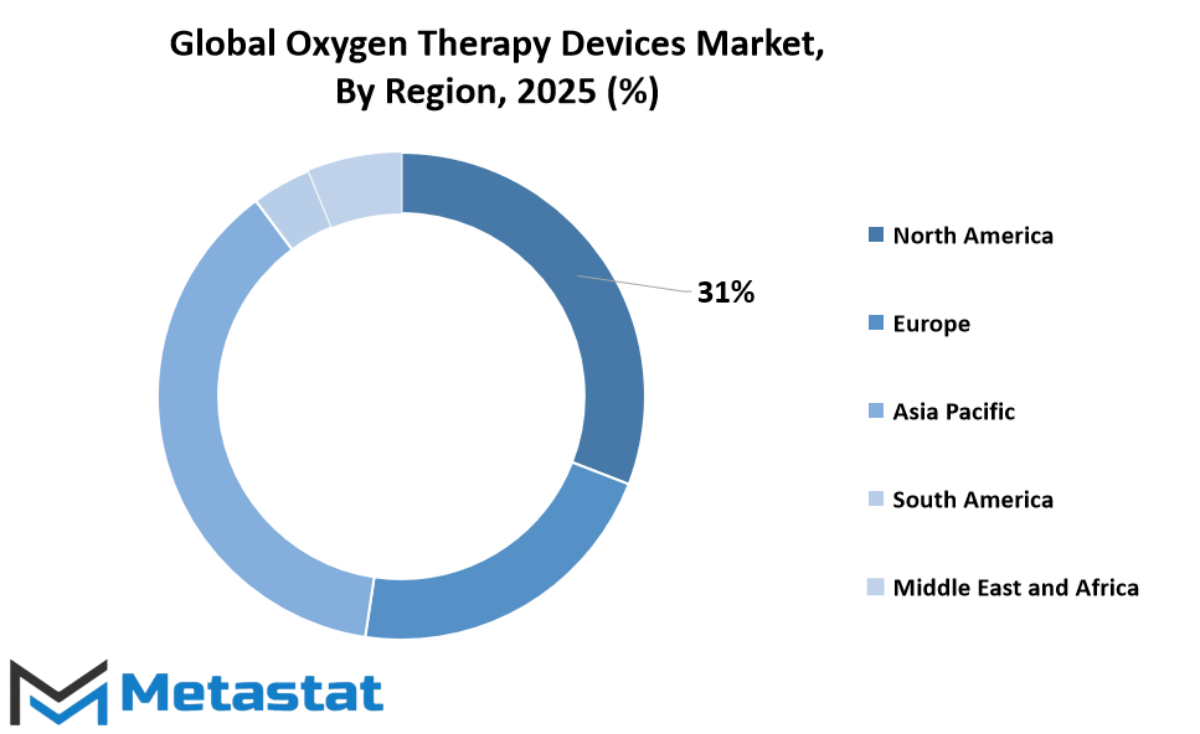
COMPETITIVE PLAYERS
The global oxygen therapy devices market is expected to grow steadily in the years ahead, supported by rising awareness of respiratory health and an aging population. As medical needs become more specific and long-term care for chronic respiratory illnesses increases, the demand for oxygen therapy devices will continue to rise. These devices are vital for treating people with conditions such as chronic obstructive pulmonary disease, asthma, and other breathing disorders. They are not only used in hospitals but are also becoming more common in homecare settings due to their portability and ease of use. In the future, this trend will likely continue, with more people relying on personal oxygen solutions to manage their conditions daily.
Key players in the global oxygen therapy devices market are taking steps to stay ahead of the competition by investing in research, improving product design, and expanding their global presence. Companies such as Philips Healthcare, Linde plc, Invacare Corporation, and Chart Industries are at the forefront, constantly working to improve the effectiveness and comfort of their products. As technology becomes more central in healthcare, we will see smarter devices with features like remote monitoring and automatic oxygen adjustment. These changes will not only make treatment easier for patients but will also help healthcare professionals manage care more efficiently.
Some companies, including Fisher & Paykel Healthcare Limited, Inogen, Inc., and Drägerwerk AG & Co. KGaA, are also focusing on energy-efficient and quiet devices. This is important as more patients choose to manage their conditions from home rather than in clinical settings. Startups and smaller manufacturers such as Longfian Scitech Co., Ltd., O2 Concepts, LLC, and TECNO-GAZ SpA are finding room in the market by offering cost-effective or specialized devices that meet unique needs. Their presence pushes larger companies to keep innovating, which helps drive growth across the board.
In the years to come, the global oxygen therapy devices market will see stronger partnerships, better distribution strategies, and more personalized care options. With key players like Drive DeVilbiss Healthcare, CAIRE Inc., and Smiths Medical, Inc. improving both product quality and access, the market is preparing for a future where oxygen therapy becomes an even more reliable part of patient care. The focus will stay on making these devices more efficient, more portable, and more user-friendly. As the global population continues to grow and live longer, the importance of advanced oxygen therapy devices will become clearer, and the companies that continue to innovate will lead the way.
Oxygen Therapy Devices Market Key Segments:
By Oxygen Source Equipment
- Oxygen Concentrators
- Liquid Oxygen Devices
- Oxygen Cylinders
By Oxygen Delivery Devices
- Oxygen Masks
- Nasal Cannulas
- Venturi Masks
- Non-rebreather Masks
- Bag-valve Masks
- Others
By Portability
- Stationary Devices
- Portable Devices
By Application
- COPD
- Asthma
- Cystic Fibrosis
- Respiratory Distress Syndrome
- Pneumonia
- Others
Key Global Oxygen Therapy Devices Industry Players
- Philips Healthcare
- Linde plc
- Invacare Corporation
- Chart Industries
- DeVilbiss Healthcare LLC
- Fisher & Paykel Healthcare Limited
- Inogen, Inc.
- Nidek Medical Products, Inc.
- Drägerwerk AG & Co. KGaA
- Drive DeVilbiss Healthcare
- CAIRE Inc.
- GCE Healthcare
- Teleflex Incorporated
- Smiths Medical, Inc.
- Besmed Health Business Corp.
WHAT REPORT PROVIDES
- Full in-depth analysis of the parent Industry
- Important changes in market and its dynamics
- Segmentation details of the market
- Former, on-going, and projected market analysis in terms of volume and value
- Assessment of niche industry developments
- Market share analysis
- Key strategies of major players
- Emerging segments and regional growth potential



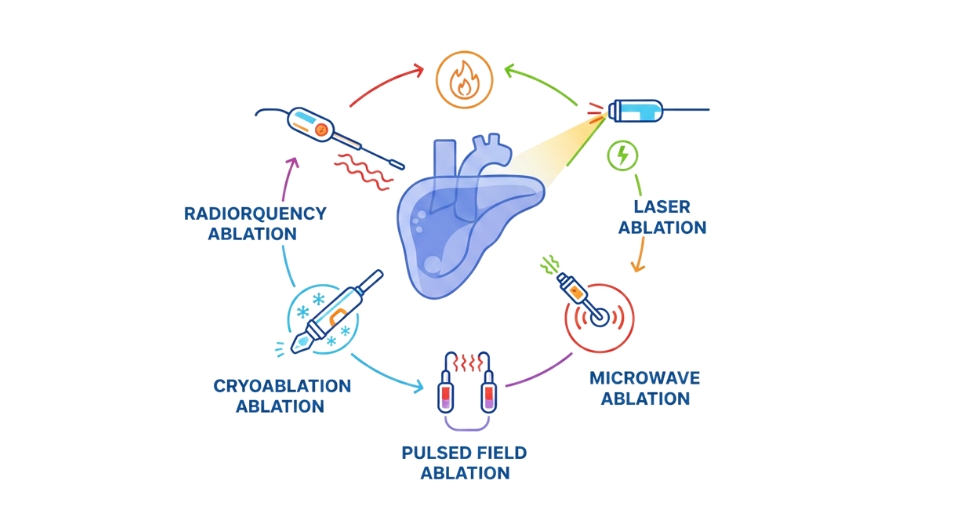

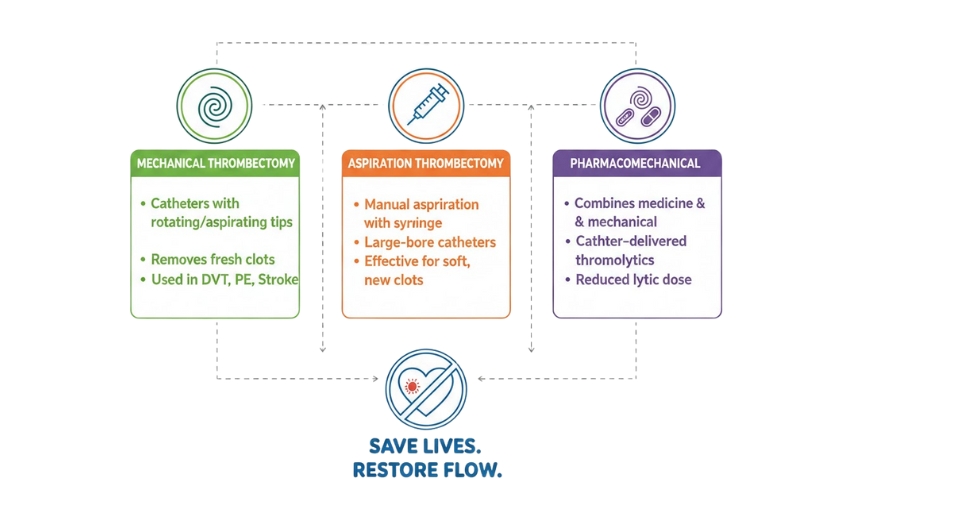
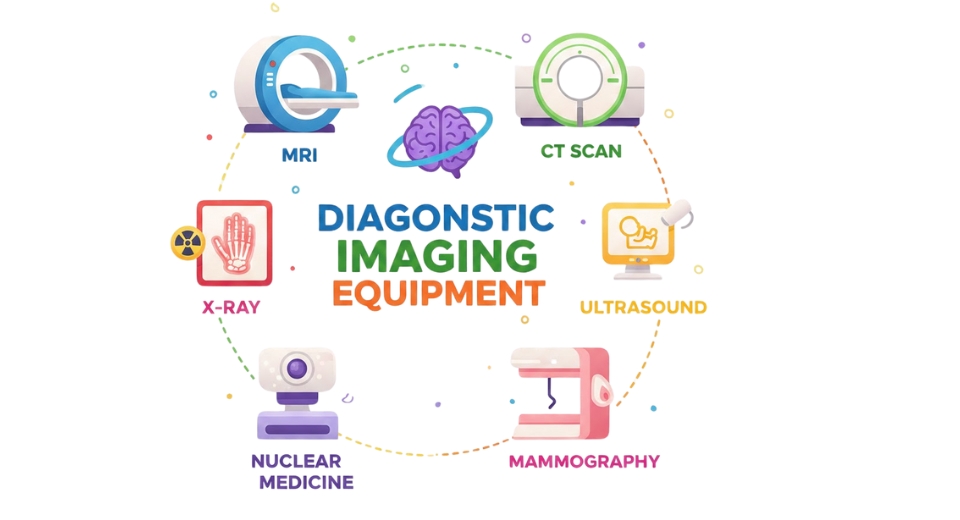

 US: +1 3023308252
US: +1 3023308252






